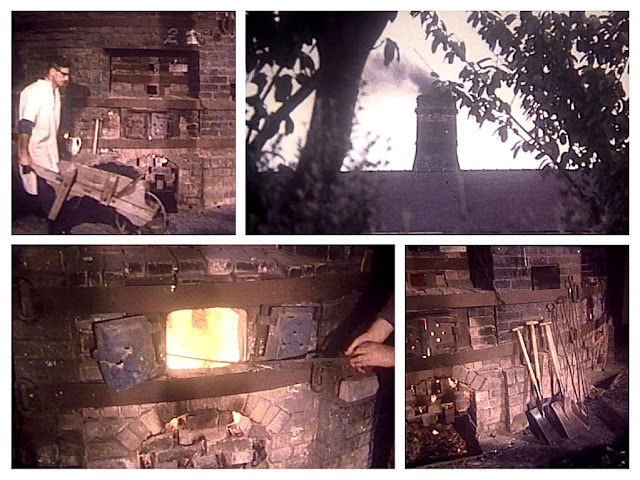Between 26th August and 3rd September 1978 one of Stoke-on-Trent's most significant cultural events of the 20th Century took place. It was the last time a traditional potters' bottle oven was used to fire pottery with coal in the north Staffordshire Potteries.
David Sekers, Director of Gladstone Pottery Museum and driving force behind the event, described it as "The first time in 20 years, the last time in history."
 |
| Fred Greasley ovenman volunteer (L) Alfred Clough fireman volunteer (R) Last Bottle Oven Firing 1978 Photo: Terry Woolliscroft Collection Date: Sept 1978 |
The traditional skills of men who knew how to fire the final oven were recorded on paper, on tape and on film. This blog shows what went on in 1978. A unique record of a unique cultural event.
A total of 11,707 visitors attended the firing event and subsequent sales events.
The Final Firing was organised by 19 staff and 72 volunteers of the Gladstone Pottery Museum, Longton, Stoke-on-Trent. Some of them were youthful and full of energy. Others were highly skilled yet quite elderly. All were enthusiastic and wanted to ensure that the expertise required to fire a traditional Potteries Bottle Oven was recorded on audio tape and on 35mm film for the benefit of future generations.
The Final Firing was organised by 19 staff and 72 volunteers of the Gladstone Pottery Museum, Longton, Stoke-on-Trent. Some of them were youthful and full of energy. Others were highly skilled yet quite elderly. All were enthusiastic and wanted to ensure that the expertise required to fire a traditional Potteries Bottle Oven was recorded on audio tape and on 35mm film for the benefit of future generations.
The audio tapes recorded over 24 hours of activities. In 2019 the digitised tapes were catalogued by a team from the Potteries Heritage Society. To get a flavour of what went on, listen to these brief extracts, selected by Alan Ingram. Click here https://potteries.org.uk/voices/last-bottle-oven-firing
"The first time in 20 years. The last time in history.
A once and for all opportunity to witness an important reminder
of our local heritage."
David Sekers, Director of Gladstone Pottery Museum, March 1977
For three centuries, Staffordshire pottery was fired using coal in hundreds of bottle ovens. Since the Second World War, they have been replaced by cleaner, gas, oil or electric kilns. The Gladstone Pottery Museum now preserves four huge majestic ovens together with one small enamel kiln. They will never be fired again. The Clean Air Act, and their delicate condition prevent it.
But in August 1978, using 12 tons of coal from the local Florence Pit, a group of increasingly elderly men who still possessed the skills required, together with a massive team of (younger) volunteers and staff from Gladstone Pottery Museum, set about firing The Last Bottle Oven.
This was the last firing, ever, of a coal fired oven, in the traditional way. A bottle oven at the Hudson and Middleton Sutherland Works, near to Gladstone Pottery Museum, Longton, was selected for the task. The whole process took 9 days - actually much longer than for a commercial oven firing - and was recorded on film for posterity.
The mastermind behind the project was David Sekers, Museum Director at the time.
The fireman responsible for the event was Alfred Clough, a local master potter and retired pottery manufacturer.
The Last Bottle Oven Firing was just part of the many and exciting years which make up The Gladstone Pottery Museum Story.



.jpg)







